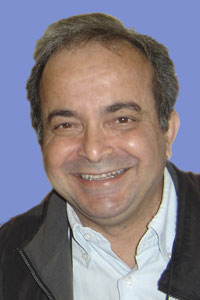
Professor Naci Balkan
It is with great sadness that we announce the death of Professor Naci Balkan on 26 June 2015. When Naci died we lost a highly valued colleague and friend.
Naci worked at the University of Essex for over 30 years, first in the Department of Physics, then subsequently, upon its closure, in the Department of Electronic Systems Engineering, where he was appointed Professor in 2002, and finally with the School of Computer Science and Electronic Engineering.
Naci began his research career when he undertook his PhD in semiconductor physics under Professor Andrew Long at the University of Glasgow. At the time, his main interest was in the field of amorphous semiconductors, in particular, Ge and Si grown with thermal evaporation or RF sputtering. The measurements he reported in his thesis entitled “Low frequency A.C. loss in tetrahedrally bonded amorphous semiconductors”, which he submitted in 1979, still form the basis of our understanding of electron transport by hopping in this material to the present day.
After his PhD he returned to Turkey, taking up a lectureship first at Hacettepe then Bogazici University where he continued his research in amorphous semiconductors and published widely on low frequency AC loss in amorphous Si and Ge.
In 1984 he joined Professor Brian Ridley’s semiconductor physics group at the University of Essex as a senior research officer, where his research interests moved to hot-electron transport, optical spectroscopy and instabilities in low dimensional III-V material systems such as GaAs/ GaAlAs and GaInAs/GaAs quantum wells. On being appointed lecturer in 1990, he set up his own research group in semiconductor materials and devices. The application of hot electrons in optoelectronic devices became the focal point of his interest. He was also engaged in the study of novel material systems for applications in optoelectronic devices, including GaN, GaInAsN, and GaInAsP, GaBiN for displays, lasers and solar cells. His work on hot-electron instabilities and hot phonons in nanostructures earned him an international reputation in experimental semiconductor physics.
In 1988 he reported the first observation of hot electron instabilities in GaAs quantum well structures associated with either acousto-electric effect or hot electron capture. In the early 1990s he demonstrated experimentally the effect of the randomization of non-equilibrium phonons on the momentum and energy relaxation of hot electrons in 2 dimensions. As a result the hot electron drift velocity is reduced and consequently, inter-valley and real-space transfer negative differential resistances are quenched and also the speed of high power FETs may be reduced drastically.
His research on hot electrons led to the discovery of novel hot-electron vertical cavity surface emitting lasers (HELLISH - VCSEL) and Top-Hat HELLISH for wavelength conversion and optical amplification. His work in hot electrons also led to the discovery of the Gunn Laser. The operation of the device is based on the recombination of impact-ionized electron hole pairs created by propagating space charge domains in GaAs biased above the negative differential resistance threshold. The operation of the device as Fabry-Perot and vertical micro-cavity surface emitting laser has been demonstrated in 2005. Both the Gunn Laser and HELLISH have been the topics of MSc and PhD projects both at home and abroad. His work on the Gunn Effect and quantum wells was unique and highly original.
He edited and co-edited four reference books on semiconductor research and co-authored a text book on semiconductors and applications in optoelectronics in Turkish, which is soon to be published in English by Springer Publishers. He also published over 200 research papers and book chapters, and edited and co-edited special issue scientific journals.
He initiated and served on the committees of prominent international scientific conferences, and was creatively involved in over 25 national and international projects as either principal investigator or co-investigator, or consultant with funding from a wide range of sources including: EPSRC, NATO, TUBITAK-Turkey, the British Council, the European Commission, the Royal Society and the University of Essex.
He was passionate about bringing scientists together from across Europe and the world to share his enthusiasm for physics. He was particularly keen to help researchers from parts of the world where developing research skills is a challenge. Over 20 PhD students and several dozen postdoctoral researchers and scientists received training in Naci’s lab. He was regarded by all as a generous and inspirational teacher.
Naci was also keen to share his passion for physics outside academia, co-writing a book on popular science, in Turkish, which is now in its 3rd edition.
Naci was truly an outstanding scholar and a gentleman, and we shall miss him dearly.